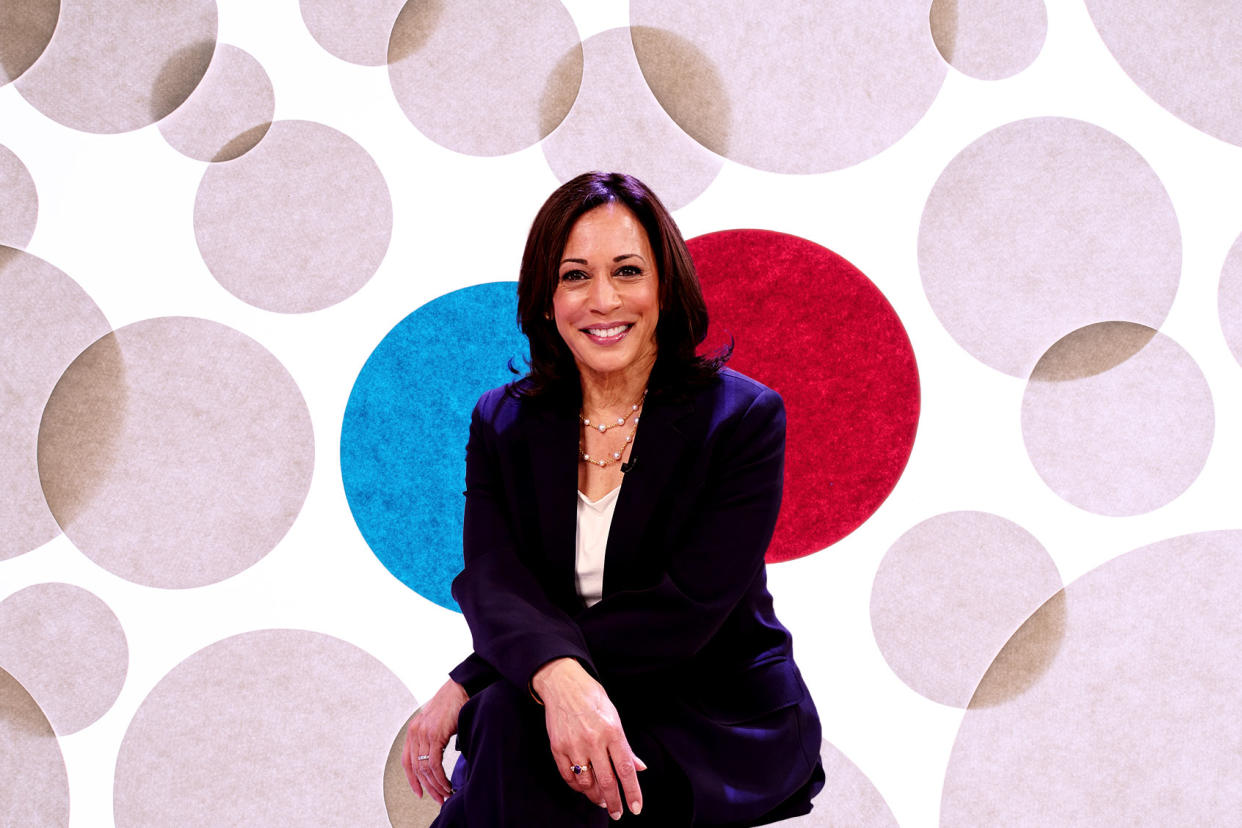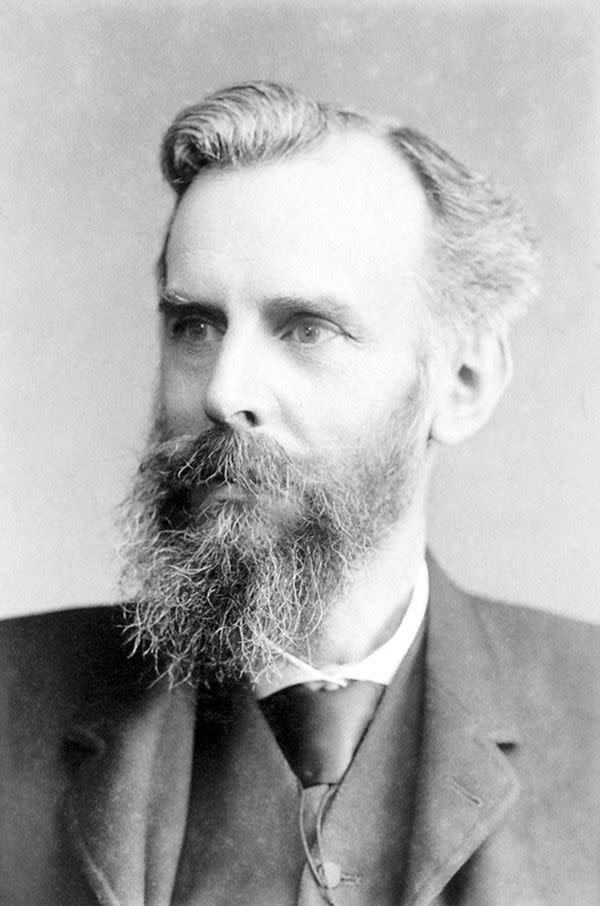Why a love of Venn diagrams is Kamala Harris' not-so-secret weapon for creating smart policy

- Oops!Something went wrong.Please try again later.
- Oops!Something went wrong.Please try again later.
- Oops!Something went wrong.Please try again later.
During a recent interview with Chrissy Teigen, Vice President Kamala Harris said, “I’m going to confess, I love Venn diagrams. If you’re ever in a moment of conflict, pull out a Venn diagram, they’ll just help you sort things out.”
This is not the first time Harris has professed affection for this logical mechanism. As a former courtroom lawyer who needed to be able to clearly demonstrate complicated inferences to juries in a way that anyone could follow, Attorney General Harris would have found Venn diagrams to be the perfect tool.
So, too, in politics. At a speech at Bryn Mawr University in 2022, for example, she produced a Venn diagram for the crowd, saying. “So, I asked my team, ‘Tell me from which states are we seeing attacks on women’s reproductive healthcare, attacks on voting rights, and attacks on LGBTQ+ rights.’ And you would not be surprised to know that there was quite an overlap, including, Florida, Georgia, Texas, Alabama, Arizona.” The overlap in these policy goals became clear to anyone who could see.
When Kimberlé Crenshaw wrote of intersectionality, she was not thinking of the common areas among the circles in Venn diagrams, however, the intersection of political rhetoric and this logical device is something that Vice President Harris mentions often. Even her campaign is getting in on the act and her supporters are following suit.
— Kamala HQ (@KamalaHQ) July 22, 2024
Republicans have seized on this intellectual infatuation, calling it cringeworthy. She was mocked by "Fox & Friends" host Brian Kilmeade who said “When you peak in third and fourth grade and become Vice President we’re doomed.”
Allowing for the straightforward visualization of logical relations, Venn diagrams were in fact designed as a teaching tool. But contrary to Kilmeade’s characterization, they are a means well beyond grade school level. They were an important step in the development of formalized reasoning that led to digital computers.
If your understanding of them comes from social media and the memeosphere, you could be excused for underestimating their power and importance in the history of ideas. Vice President Harris may proclaim her adoration of them in public more frequently than she does for her husband, but looking at the development of logic, Doug Emhoff has not done anything quite like John Venn.
Here's a history tracing the meticulous development of the Venn diagram to better understand how we got to the useful visual tool we still employ today.
Not just blind luck
With the exception of the Olympics’ insignia, Venn diagrams are our most recognizable overlapping circles. Named after Cambridge University mathematician and logician John Venn, they first appeared in his book "Symbolic Logic" in 1880. In that work, he named them after a different mathematician calling them “Eulerian circles.”
Leonhard Euler was a Swiss mathematician whose 866 published mathematical papers are the most of anyone in history. To make this even more impressive, he did much of this work while blind. One focus of his work was taking complex mathematical reasoning and operations and representing it using symbols so that instead of having to think through long chains of inferences, we could instead manipulate symbols according to simple rules.
As a result, he generated many of the standard representations we still use. Why is the letter x used for an unknown quantity in algebra? Euler. Why do we use the Greek letter π for the ratio between a circle’s circumference and diameter? Euler. Why is the square root of -1 called i? Euler.
In his quest to make complicated (and in the case of i, complex) mathematics simpler, Euler came upon a way to use circles to represent class membership. This allowed for a teaching tool that made certain logical relations clearer because they could be simply seen. Euler’s diagrams were effective, but Venn soon realized that they were limited in their applicability. Euler’s circles could not do something that a modified approach could — allow for a mechanical way of doing logic. Venn, with his new twist, would out-Euler, Euler.
Who, what, where and Venn
John Venn was the son of an Anglican minister whose interest was not in the Divine order of the universe, but rather its underlying mathematical structure. Attending Cambridge, he sat for the Mathematical Tripos, a grueling eight-day exam that largely tested one’s ability to quickly calculate for extended periods of time. Venn described the event as “fearfully hard work, both physical and mental.”

Venn did well enough, achieving the rank of sixth wrangler, that is, placing sixth in his class, which was impressive, but not prestigious. The outcome, however, was intense burnout. He had loved mathematics, but now could not stand to think about it. “[B]efore coming to Cambridge and for my first year or two, I had a real enjoyment in the subject,” Venn wrote in an unpublished autobiographical sketch, “I never made any study of it afterwards: and in fact felt almost a repulsion towards it.” He sold all his mathematics books. He was done with it.
But eventually, his old love started nagging at him. He knew there had to be more to math than just cranking through problems. There were deep philosophical questions buried in it. Searching for others who also sought the intellectual depths of the field, he found George Boole.
A load of Boole
Work with computers long enough and you are sure to hear the phrase “Boolean algebra,” which refers to the machine’s underlying logic. It was formulated by Boole, an Irish mathematician and logician, who redirected the study of reasoning.
The word “logic” comes from the Greek term “logos” which is the root for our suffix -ology. Geology is the logic of “geo,” the earth. Biology is the logic of “bio,” life. Literally, “logos” translates as the word for “word.” Logical reasoning is the set of reasonable words that leads the hearer to understand something. Logic was the structure of well-reasoned discussion.
But Boole wanted to make good reasoning rigorous. He wanted a sort of mathematical calculation that could help us determine whether a sentence was true or false based on the evidence adduced for it. He developed this for basic terms like “and” and “or.” He showed that we could build algorithms to demonstrate the necessary truth of certain kinds of arguments.
We start with two truth values — true and false — and strictly build the conditions under which an “and” sentence is true and an “or” sentence is true and we can then start to develop a turn the crank method, an algebra, that would tell us whether a set of “and” and “or” sentences would lead to a specified conclusion or not.
A century later, this algebra could be built into electrical circuits which could be placed in series or parallel to allow Alan Turing to create the first electronic computer to break the Nazi enigma code and later more advanced versions to stream unlimited cat videos.
Categorical denial
Venn became fascinated with Boole’s new approach to logic and in finding a way to reduce logic to simple calculations. He tried to use Euler’s circles to illustrate Boole’s algebra of truth-values, but Euler’s representational system would not quite do the trick.
But while he could not use Euler to account for Boole’s new approach, Venn realized that he could accomplish something else just as important. He could restructure Euler’s circles to automate classical logic.
Before Boole, formal logic came from the writings of Aristotle. In his book "Prior Analytics," Aristotle works out the logic of “the categorical syllogism.” A syllogism is any argument that has a conclusion supported by two premises. Consider the old chestnut, “All Greeks are mortal, Socrates is Greek, therefore Socrates is mortal.” That is a syllogism.
A syllogism is “categorical” if the conclusion and two premises are of categorical form, that is, is a sentence of the type “All A are B,” “No A are B,” “Some A are B,” or “Some A are not B.” Each part of the argument will have one of these four forms, although the A and B categories could be in either order.

We see examples of categorical propositions in Vice President Harris’ words. Consider her questioning of Justice Brett Kavanaugh at his confirmation hearing when she asked, “Can you think of any laws that give the government power to make decisions about the male body?” She got Judge Kavanaugh to uncomfortably consent to the truth of the categorical sentence, “No laws are impinging on male bodily autonomy.” In her comments after meeting with Israeli Prime Minister Benjamin Netanyahu, she said, “So to everyone who has been calling for a cease-fire, and to everyone who has been calling for peace, I see you and I hear you.” This is equivalent to “All people calling for an end to the hostilities in Gaza are people whose concerns she acknowledges.” Categorical propositions of the sort Aristotle was considering are normal in day-to-day reasoning.
It turns out that there are 256 ways to arrange three categorical sentences into a syllogism. We are interested in finding the ones that are valid, that is, if the premises are true, then the conclusion must be as well. These are the good forms of reasoning that give us reason to believe the conclusion. Of these 256 argument forms, only 15 are valid. Aristotle developed five rules which determine if any given argument form is valid. While this system of rules worked, however, it was hard to see why they were successful.
Venn I find myself in times of trouble
Venn’s great realization was that he could alter Euler’s diagrams to construct clear visual representations of all four of Aristotle’s categorical propositions built on a common template, the iconic two interlocking circles. “All A are B” means that the area of the A circle that is not a part of the B circle is empty. He shaded in the empty part. “No A are B” means that the intersection of the two circles was empty, so it was shaded. “Some A are B” means that the intersection of the two circles was not empty, that there was at least one thing there, so put an x there to represent it. And finally “Some A are not B” means that the part of the A circle that is not a part of the B circle has at least one thing in it, so put an x there.
A categorical syllogism includes three categories, call them A, B, and C. One premise would involve A and B, the other would relate B and C, and then the conclusion would be a statement about A and C. So, if we were going to move from representing single propositions to illustrating the entire syllogism, we need a new sort of diagram, the one with three interlocking circles that Vice President Harris is so enamored with. “I love Venn diagrams, It’s just something about those three circles.”
I love Venn diagrams https://t.co/n0GyeK7gVS pic.twitter.com/DnLXXk9usg
— Sean Butler (@Sean_Butler1) July 18, 2024
Venn recognized that he could use the two circle representation of each of the premises in the three circle diagram and what came out was what those two sentences entailed. So, diagram the A/B premise and the B/C premise onto the three circles. If what comes out when we look at the A/C circles entails the representation of the form of the conclusion, BOOM, the argument is valid. If it was not exactly what the conclusion’s diagram would look like, then it was not.
Venn gave us a simple, turn-the-crank means of clearly seeing why the 15 forms of the Aristotelian syllogism – and only those 15 forms – are valid. All of a sudden logic went from a set of abstract seemingly arbitrary rules to a mechanical, easily visualizable practice that governed good reasoning. (Interestingly, another mathematician, Charles Dodgson, better known by his pen name Lewis Carroll, came up with an equivalent system using squares at about the same time just 100 miles away at Oxford.)
Venn’s success inspired other logicians to try to do the same with Boolean algebra. A couple of decades later, Gottlob Frege with his "Begriffsshrift" and then Bertrand Russell and A.N. Whitehead with their "Principia Mathematica" did just that, and modern logic was born.
Love and logic
Any logician will tell you that there is a lot to love about Venn diagrams, but what does Vice President Harris’ love of them tell us about her?
It is clear from the context of her repeated invocations that she uses Venn diagrams to clarify complicated situations. “Whenever I am presented with kind of like ‘this is complicated,’” she recently said in an interview at the University of Southern Nevada, “I always wonder ‘Is there a Venn diagram?’”
Scientists speak of dependent and independent variables. In reality, lots of things are connected to other things and changing one affects the others, whether you mean to or not. Her use of Venn diagrams shows that Vice President Harris understands that the world is full of interlocking elements and that effective policy requires not just changing what needs to be fixed, but doing so in a way that does not create unintended negative consequences elsewhere. Her use of Venn diagrams seeks to clarify without simplifying, to give a clear picture of interrelations without ignoring their existence.
It is often the case in policy debates that ideology determines policy prescriptions, side effects be damned. When someone points them out, just yell louder about how bad the problem is and draw attention away from the unintentional outcomes. Does eliminating sex ed increase demand for abortions? Does raising the minimum wage increase inflation? These are the sort of important questions that need to be honestly wrestled with when proposing new laws and regulations, but which we all too often – no matter where you are on the political spectrum – tend to ignore. Al Gore told us that some truths are inconvenient and too often we downplay them because of their inconvenience instead of contending with them because of their truth.
But someone who professes her love for Venn diagrams is signaling to us an intellectual orientation that begins with the axiom that categories intersect, that domestic and foreign policy matters do not exist atomistically disconnected from everything else, that there is a fundamental complexity to the world that cannot be eliminated.
Yet, it also points to a hopefulness that this intricate interweaving implicit in the real world can be understood. We can model the fact that the political knee bone is connected to the economic leg bone is connected to the social hip bone. It is indicative of a mind that accepts complexity and seeks to account for it, instead of oversimplifying it into a false but attractive narrative.
We should take comfort in someone who may end up in the world’s most difficult job loving Venn diagrams. She is utilizing an intellectual instrument that changed the way we think about thinking, that constructed a way to make sure we were reasoning properly, and that showed us why valid argumentation is a matter of fact and not mere opinion . . . and those are logical, not alternative facts.

